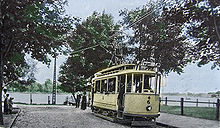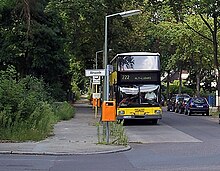Tegelort
Tegelort is a locality in the Reinickendorf district of Berlin and is located in the Konradshöhe district . The name is derived from the former name Tegelscher Orth . Tegelort is surrounded by the Tegel Forest , as well as the Havel and Tegeler See . Tegelort is around 31 meters above sea level . The location is connected to the Spandau district of Hakenfelde by a car ferry that leads across the Havel to Aalemannufer .
history
The Feldmark of Heiligensee
The current location of Tegelort was originally completely forested and formed the southernmost part of the Feldmark of the Heiligensee community .
Only a few unpaved sand paths led into this area between the Havel, Tegeler See and the "Königliche Heyde", the later Tegeler Forest. For a long time, farmers, hunters and mushroom pickers were the only visitors to this remote region between forest and water. Barge skippers had laid a towpath on the east bank of the Havel . This riverside path has been preserved as a popular promenade to this day.
Around 1600 the Heiligensee farmers began to clear the field mark in order to open up new arable land . Between 1753 and 1767 they cleared and cultivated the parcel of Dornteile, which was largely in the area of today's Tegelort. However, the soils of the newly ordered parcels were too sandy and therefore barren. The meager yields meant that agricultural use was not carried out here on a permanent basis.
Nevertheless, on October 22nd, 1822, the Heiligenseer Kossaten leased 70 acres of woodland southeast of the Dornstücks (the area between Grenzstraße, today: Beatestraße, and today's Theresenweg). Because of its proximity to Lake Tegel, these first settlers called the Kossatenacker that arose there Tegelscher Orth.
The colonies until 1914
The founding years that began in the German Reich after the Franco-Prussian War in 1870/1871 were also reflected in the establishment of today's Tegelort location. In 1872, the Berlin dyer Carl Berger acquired a water piece of land in today's Scharfenberger Straße from the Heiligenseer Kossaete couple Grieft. The Tegelort colony developed from the Bergers house, consisting of a few hundred houses and a dozen restaurants. The restaurant Tegelort, later Seegarten, built by Berger, still stands today, albeit as a ruin. It is the oldest building in Tegelort.
The Jörsfeld colony was also founded by a Berlin entrepreneur. The hat manufacturer Otto Joers bought the land of "his" colony from Heiligenseer farmers, which was located roughly in the area north of the Jörsstrasse named after him. Until the 1940s, this part was called Jörsfelde by the residents . In 1896 Tegelort was officially declared a “villa suburb of Berlin”.
Some residents founded the Tegelort volunteer fire brigade in 1902 , and in 1905 the fire station in Bismarckstrasse (today: Friederikestrasse) was inaugurated. The fire station was rebuilt and expanded several times over the next few decades and received a. 1929 a fireboat with a boathouse. In 1904 Otto Joers gave the Heiligensee community a piece of land in Luisenstrasse for a school building. It became necessary because the population in the colonies was constantly increasing. The school opened just one year later and was also attended by children from the Konradshöhe colony. In 1911, a postal agency with a telegraph was also opened.
A decisive infrastructure measure for the colonies took place in 1913 with the opening of the south branch of the tram of the community Heiligensee on the Havel from Tegel to Tegelort. The new fast transport connection to the outskirts of Berlin was a great impetus for the further settlement of Tegelort and Jörsfelde. In particular, tourism , which lured thousands of Berliners “into the countryside” in the summer months, benefited from the tram. The line was integrated into the Berlin tram network in 1920 and discontinued in 1958. In 1909 the community of Heiligensee established a gas station in Sandhausen to supply the colonies with gas. Until before the First World War , Tegelort and Jörsfelde were essentially built up to the extent they are today.
1918 to 1945
The municipality of Heiligensee with its three colonies Tegelort, Jörsfelde and Konradshöhe was incorporated into Greater Berlin in 1920 and became part of the newly created administrative district of Reinickendorf . After the inflation , Tegelort and Jörsfelde experienced another surge in construction and settlement. The last of the arable land was sold and cultivated, the number of inhabitants doubled within a decade. From the 1920s onwards, it was connected to the Berlin electricity and water supply network. In the summer of 1930, a car and passenger ferry started operating between Jörsstrasse in Tegelort and Aalemannufer in Hakenfelde . This ferry connection still exists today.

The 1920s and 1930s were the heyday of Tegelort's tourist restaurants. Excursion steamers and trams could hardly contain the numerous guests who poured into the restaurants from Berlin. In addition to gastronomy in the true sense of the word, several “amusement parks” opened their doors, offering cable cars , carousels , bowling alleys , theaters and cinemas. Especially the Scharfenbergerstrasse and Birkenstrasse (today: Edeltrautweg) were strongholds of the Berlin weekenders. In addition to numerous restaurants, water sports became a crowd puller. Several associations, clubhouses and boathouses, some of them still remember it today. The Tegelsee bathing area opened in 1932 and has enjoyed great popularity every summer since then.
A memorial stone is dedicated to two resistance fighters against the Nazi regime from Tegelort and Konradshöhe in Konradshöhe. Albert Brust (from today's Friederikestrasse) was a machine fitter at Rheinmetall-Borsig in Tegel and headed the company resistance group there. He was executed on September 26, 1944 in Brandenburg prison. The Second World War did comparatively little damage in Tegelort. Because of the loosened development, wildfires were prevented. Among other things, the "landmark" of Tegelort, the Leuchtthurm restaurant , which opened in 1890, was destroyed in an air raid, killing 24 people. On April 23, 1945 at around 3 p.m. the Red Army marched into Tegelort without a fight.
1945 until today
For a short time, Soviet troops confiscated part of the residential buildings, and a little later Tegelort was taken over by the French occupying forces . They set up the officers' home “Bir Hakeim” on Scharfenberger Strasse (see Battle of Bir Hakeim ), which existed until the mid-1950s.
In 1950 Tegelort became a district of the Reinickendorf district together with Konradshöhe as Konradshöhe . The terms Jörsfelde and colonies are no longer in use today. In the post-war period , the term climatic health resort came up for Tegelort , although this was never officially confirmed. Nevertheless, Tegelort has comparatively clean air to this day due to the large areas of water and forest surrounding it. In 1953, a new building for the Tegelort school in Gerlindeweg was inaugurated, which (with extensions from 1995) is still in use today and in 1969 was named the primary school at Tegelschen Ort . The historic school building on Luisenstrasse has housed a health center since 2008.
The Berlin underground line C (today U6 ) was expanded to Tegel in 1958. In this context, tram traffic from Tegel to Tegelort was discontinued and replaced by the BVG with bus line 20 (now 222). In 1961, the Tegelorter streets were given their current maiden names, and in 1974 the last gas lamps were replaced by electric street lighting. With the connection of the last Tegelort plots to the Berlin sewer system in the 1980s, the technical infrastructure expansion in Tegelort was completed.
The primary school Am Tegelschen Ort is located in Tegelort and is the first educational institution for most primary school students from Konradshöhe and Tegelort as well as some students from Heiligensee and Tegel. In addition, Tegelort has a volunteer fire brigade that also operates outside of Tegelort.
The location is still a popular destination for tourists and weekenders and therefore has hotels and restaurants. There are several jetties for excursion boats.
literature
- Jörg Müller: Konradshöhe. From the Hinterfeld to the climatic health resort. In: Support group for culture and education in Reinickendorf e. V. (Ed.): Chronicle of the Reinickendorf district of Berlin, part 2. Berlin 1990.
- Michael Zaremba: Reinickendorf in the course of history. Berlin 1999.
Web links
Coordinates: 52 ° 34 ' N , 13 ° 14' E









